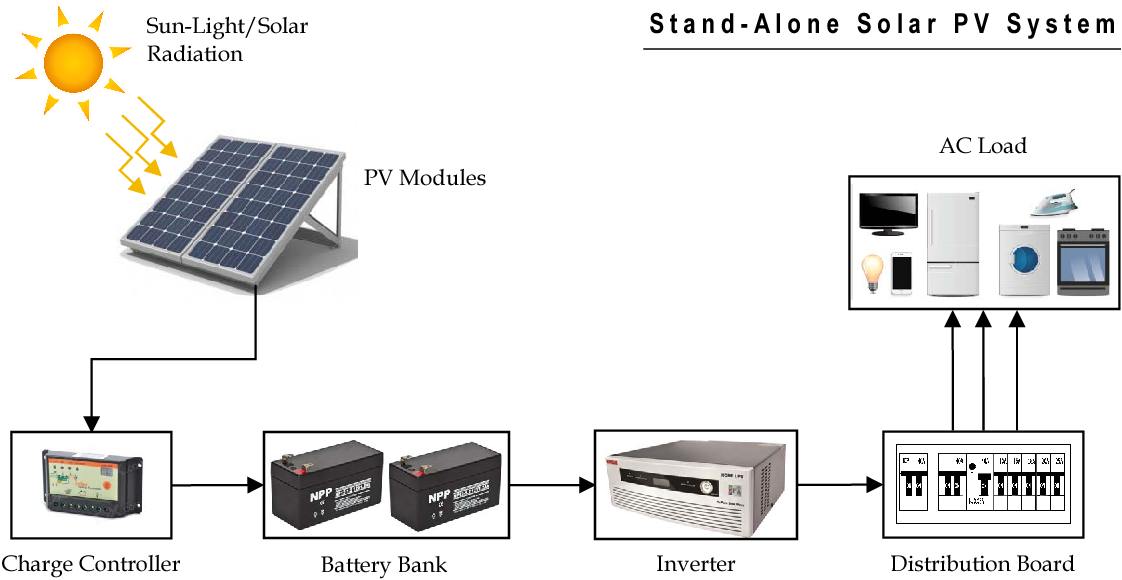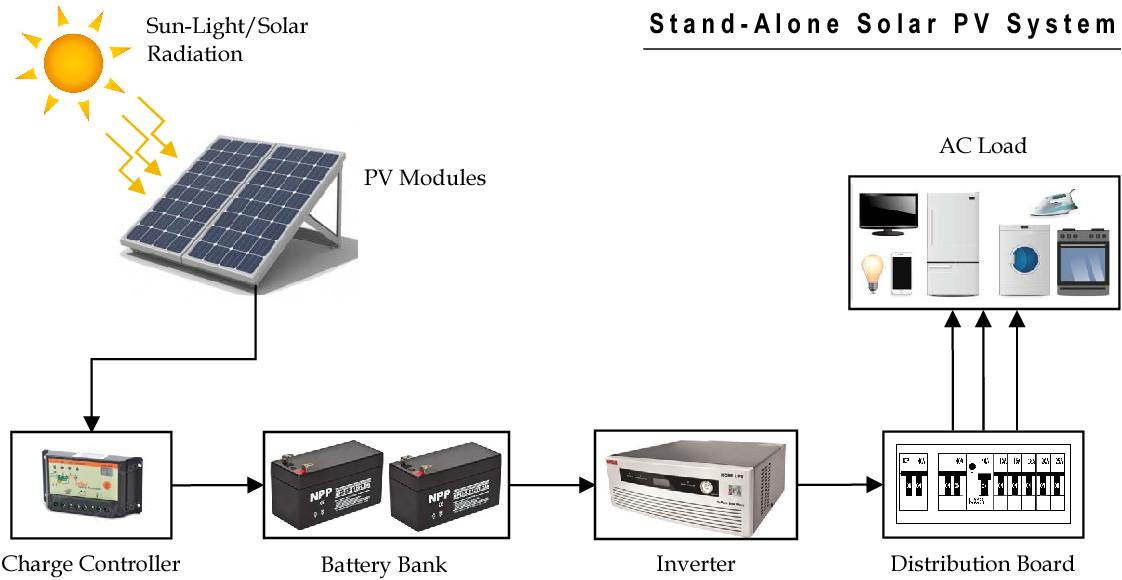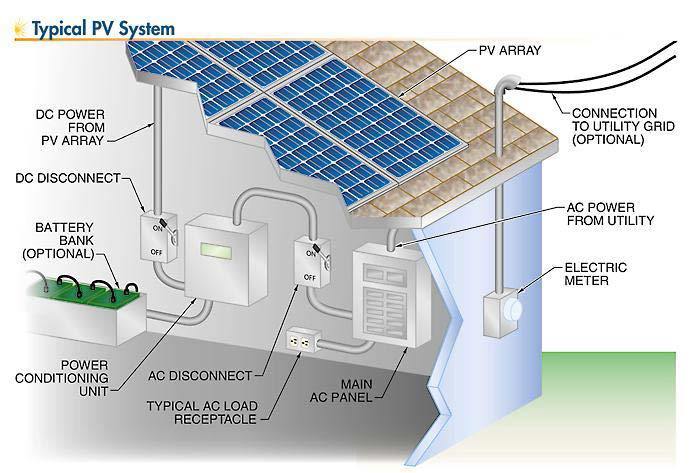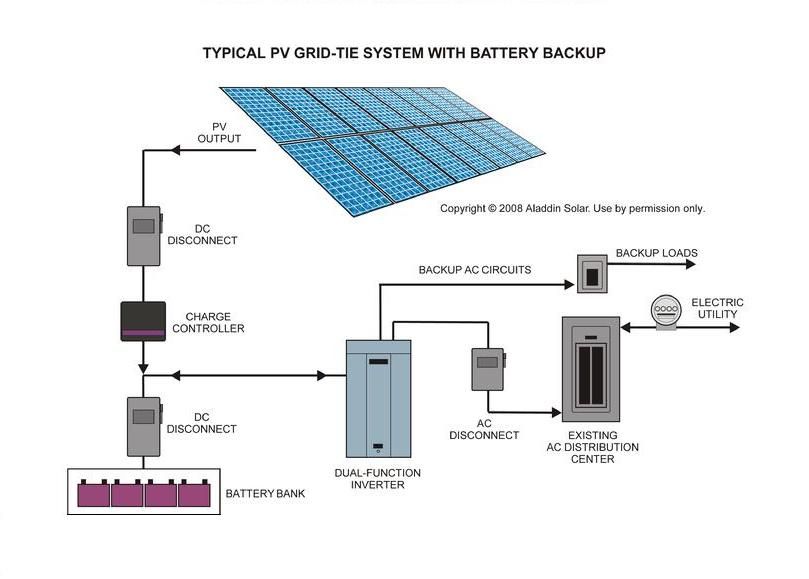A Bifurcation between ON and OFF Grid PV system

Introduction
Homes and businesses are by far the most common and widely used on-grid or grid-tie solar systems. These systems do not need batteries and are connected to the public electricity grid, using either solar inverters or micro-inverters. Any excess solar power you generate is exported to the electricity grid and the energy you export is usually paid a feed-in tariff (FiT) or credits. Unlike hybrid systems, due to safety reasons on-grid solar systems are unable to function or generate electricity during a blackout. Since blackouts usually occur when the electricity grid is damaged; if the solar inverter still fed electricity into a damaged grid, it would risk the safety of people repairing the network’s faults. Most hybrid solar systems with battery storage can isolate from the grid automatically (known as islanding) and continue to provide some power during blackout. Where required, batteries can be added to on-grid systems at a later stage. “The Tesla Powerwall 2” is a popular system with AC batteries that can be added to an existing solar system.
On the other hand, an off-grid system is not connected to the electricity grid, so battery storage is required. Off-grid solar systems must be appropriately designed to generate sufficient power throughout the year and have sufficient battery capacity to meet the needs of the home, even in the depths of winter when there is generally far less sunlight. The high cost of batteries and off-grid inverters means off-grid systems are much more expensive than on-grid systems, so they are usually needed only in more remote areas far from the grid. Battery costs are rapidly decreasing, so there is now a growing market for off-grid solar battery systems even in cities and towns.
Stand-alone PV systems

The system that uses only solar electric energy as the main energy source is referred to as a standalone solar electrical system. There are many places on this Earth where there is no source of electricity. Standalone solar electric systems can be the ideal source of electricity at these locations. The main benefit of this system is that it doesn’t depend on grid or any other electricity source. It is also known as off-grid Photovoltaic system, because it has no grid connection or other electrical supply line. Since the sun is the only source of energy in this system it should have some means to activate it even in the night. A battery storage system does the job. Hence, a battery storage system is an essential component of a standalone solar system. However, this battery system can often be omitted from the system if the system is dedicated to the load that only needs to be operated during the day. Solar lanterns, solar home lighting systems, solar water pumping systems are popular examples of standalone solar systems.
Battery banks
Battery failure has often caused suboptimal performance of the power system. This is undoubtedly not the area for cutting expenses. The battery bank must be of the highest quality available for any power system, the correct type for the application and sufficient capacity to ensure that the discharge depth does not exceed the design parameters. The size of a battery bank can be surprisingly large for even relatively low-power applications, especially if autonomy is a design requirement year-round. Also, cold temperatures cause, lower capacity but tend to increase battery life. The lead acid battery is the most common type of battery found in PV-systems. Other types of rechargeable batteries exist, including nickel-cadmium (NiCad), nickel metal hydride (NiMH), nickel-iron (NiFe), lithium ion, and lithium polymer batteries. Lithium polymer batteries are showing significant promise for wider use in autonomous power systems. These types of batteries show up to four times greater energy density and increased performance over a wider temperature range, to which this emerging technology might ultimately favour. In a few polar applications, NiCad batteries were used, because they have superior performance in extreme cold.
Charge controllers
A solar charge controller is essentially a voltage or current controller for charging the battery and preventing overcharging by electric cells. It directs the voltage and current from the setting solar panels to the electrical cell. In general, 12V boards/panels are placed in the 16 to 20V ballpark, so if there is no regulation, the electric cells will damage due to overload. Generally, it takes around 14 to 14.5V for electrical storage devices to get fully charged. Solar charge controllers are available in all functionality, cost and size. Charging controllers range from 4.5A and up to 60-80A. Basically, the most essential charge controller controls the voltage of the device and opens the circuit, stopping the charge when the voltage of the battery rises to a certain level. More charge controllers used a mechanical relay to open or shut down the electrical storage devices circuit, stop or start power heading off. Solar power systems generally utilise 12V batteries. Solar panels can convey a lot more voltage than battery charging is required. The charge voltage could be kept at the best level, while the time required to charge the electrical storage devices completely is reduced. This allows constant working of the solar systems optimally. By running higher voltage in the wires from the solar panels to the charge controller, the dissipation of power in the wires is fundamentally diminished. Also, the solar charge controllers can control the flow of reverse power. The charge controllers can distinguish between the solar panels when no power is coming from them and open the circuit separating the solar panels from the battery devices and stopping the reverse current flow.
Main DC disconnect

Automatic and manual safety disconnections protect the wiring and components from power surges and other malfunctions of the equipment. They also make sure the system can be shut down safely and that system components can be removed for maintenance and repair. Safety disconnects for grid-connected systems ensure that the generating equipment is isolated from the grid which is important to the safety of utility personnel. In general, every power source or energy storage device in the system requires a disconnect.
The DC disconnect array, also called the PV disconnect, is used for the maintenance or troubleshooting purposes to safely interrupt the electricity flow from the PV array. Also, the DC disconnect array may have circuit breakers or fuses built in to protect against surges in power. The DC disconnect inverter is used for secure disconnection of the inverter from the rest of the system. In many cases, disconnecting the DC inverter will also serve as disconnecting the DC array.
System monitoring meters
Photovoltaic system monitoring, and control is essential for the reliable functioning and maximum yield of any solar electric system. Read values on display can perform the simplest monitoring of an inverter-display (usually LCD) is part of almost every grid-connected inverter. In such cases the most important parameters related to the inverter and grid are available on the LCD screen. Values such as power of PV array, power of AC grid, current of PV array are normally available. Environmental data can also be logged, stored and analysed later for sophisticated monitoring and control purposes such as module temperature, ambient temperature, solar radiation, wind speed. Different remote connections allow remote control and monitoring: analogue modem, ISDN, GSM etc. For local/remote control the most common connection is USB and inverter interconnection power line. Bluetooth and Wi-Fi are used the most commonly for wireless network.
There are two types of monitoring systems:
- Local monitoring
- Remote monitoring
1] Local monitoring: The simplest way of carrying out local monitoring is to display it on the inverter or on the inverter control unit. Other local monitoring possibilities include monitoring by local PC via, for example, RS232 connection and/or remote display located in the living room (usually wireless connection between the inverter and display). Usually the following parameters can be monitored, data-logged and stored for a particular time (usually up to 1 year) in the inverter’s memory or external data logger. Other sensor related units (external or internal) are also sometimes required:
| Parameters | Abbreviations | Units |
| Array voltage | Vdc | V |
| Grid voltage | Vac | V |
| Array current | Idc | A |
| Grid current | Iac | A |
| Array power | Pdc | W |
| Grid power | Pac | W |
2] Remote monitoring: With wireless connection (Bluetooth or Wi-Fi), via RS485 interface or via grid (powerline connection), remote control and communication between the inverters can be realised. There is no problem with distances of up to 1200 m, several tenth inverters can be connected in chain and monitored at the same time. Various ways of communication can be used for remote monitoring: Ethernet, Internet, dial up access, GSM etc. System can send alerts and status messages to the user or the control centre. Users can send alerts and system messages via SMS service, GSM, fax machine etc.
Net metering

Net metering (also known as net energy metering or NEM) is a solar incentive that allows the electric grid to store energy. In exchange for credits, if your solar panels produce more electricity than you need, that energy is sent to the grid. Then you pull energy from the grid at night or at other times when your solar panels are under production and use these credits to offset the cost of that energy. You can generate enough electricity with the right size solar energy system to match the use of electricity in your home for the whole year. The amount of electricity produced by your solar panels will vary though throughout the year. Net metering helps you to account for these differences by crediting your panels for excess electricity, so you can use it later.
Bi-Directional electric meters
Bi-Directional Meter senses current flow direction and stores the data for your consumption and electricity production in separate registers. This metre is capable of measuring electricity flow in two directions. I.e. both inbound and outbound at the same time. Most of the loads are in off-state during the daytime. Thus, in the case of a grid tied system, the excess energy produced from your solar plant must be fed back to the grid. At this point, current flow direction is retrograde from your home system to the grid. The energy metre records the data in the register for exports. No solar generation occurs in the night, and electricity is imported from the grid or electric company to run the building load. Now the current flow direction is forward, and the metre records the data in the import register. So basically, the bi-directional meter lets you get your energy generation information – export, import from your Solar PV plant system, and grid. It also measures the difference between the production of the generators and the load demand of the customers. Our metre does not measure electricity production from the generators. The generator can offset any excess electricity produced by a customer’s use of electric energy. Given that the generator system produces electricity, the kilowatt-hours are first used to meet the electrical requirements of the customer, such as lighting and appliances. The additional kilowatt-hours are measured, fed into the electrical system of the utility and used by other customers if more electrical energy is produced from the system than the customers require. When calculating the monthly electric bill, the customer only pays for the net kilowatt-hours (kWh) if the customer uses more electrical energy than is generated. If the customer generates more electrical energy than the electrical utility system uses, then the customer receives a credit of kWh which will be applied to future bills. In addition, the customer is required to pay any applicable customer fees and oscillations under their tariff schedule.
Grid-tied system with Battery backup

Traditional grid-tie systems are systems in which solar panels are placed as a roof mount, a ground mount, or elsewhere, and then the light and energy from the sun is collected through the panels and then transferred to an inverter, which converts the power into usable energy. There is a connection with the utility company with the basic grid-tie system, however, there is no battery backup system, and so if a power outage were to occur, your reliance on grid connectivity means that you would be completely powerless even with the solar panels installed. And so, so as not to be stuck without power and be able to remain self-sufficient in an emergency. The best option is to have a battery back-up grid system that gives user the option to use and build credit with the utility company when needed, and to be self-sustaining in the event of an emergency.
Conclusion
There is a cost associated with electrifying houses which increases with the distance between the grid and the houses. Such instances where one can always use an off-grid PV system when the electrification costs become enormously high. Both system types. On-grid and off-grid PV systems have their own pros and cons. One can decide what they would like to go for depending solely on the need. It’s a trend that one can observe is that the grid-tied system is found mostly in urban and suburban settings where the area has already been electrified. The off-grid system is more suitable for areas where electrification is still to be accomplished and the consumer chooses not to return the energy generated at the end of the system.

